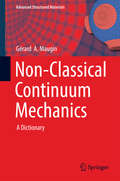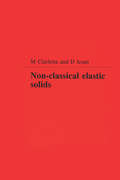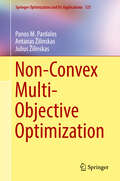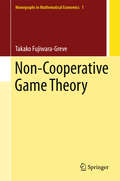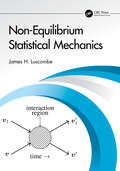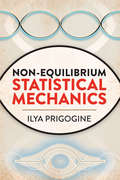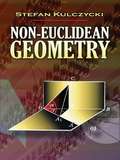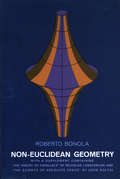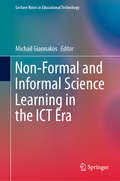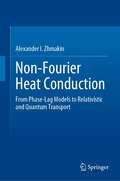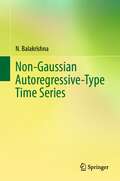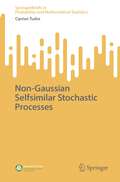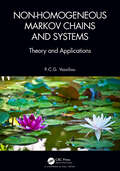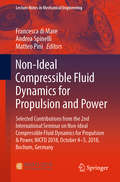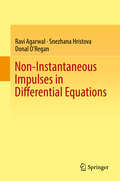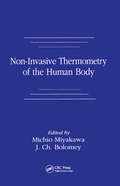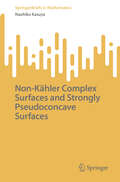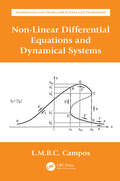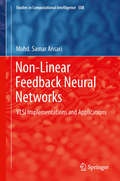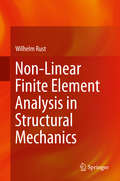- Table View
- List View
Non-Classical Continuum Mechanics: A Dictionary (Advanced Structured Materials #51)
by Gérard A. MauginThis dictionary offers clear and reliable explanations of over 100 keywords covering the entire field of non-classical continuum mechanics and generalized mechanics, including the theory of elasticity, heat conduction, thermodynamic and electromagnetic continua, as well as applied mathematics. Every entry includes the historical background and the underlying theory, basic equations and typical applications. The reference list for each entry provides a link to the original articles and the most important in-depth theoretical works. Last but not least, every entry is followed by a cross-reference to other related subject entries in the dictionary.
Non-Classical Elastic Solids (Chapman & Hall/CRC Research Notes in Mathematics Series)
by Michele Ciarletta D. IesanProblems concerning non-classical elastic solids continue to attract the attention of mathematicians, scientists and engineers. Research in this area addresses problems concerning many substances, such as crystals, polymers, composites, ceramics and blood. This comprehensive, accessible work brings together recent research in this field, and will be of great interest to mathematicians, physicists and other specialists working in this area.
Non-Convex Multi-Objective Optimization (Springer Optimization and Its Applications #123)
by Panos M. Pardalos Julius Žilinskas Antanas ŽilinskasRecent results on non-convex multi-objective optimization problems and methods are presented in this book, with particular attention to expensive black-box objective functions. Multi-objective optimization methods facilitate designers, engineers, and researchers to make decisions on appropriate trade-offs between various conflicting goals. A variety of deterministic and stochastic multi-objective optimization methods are developed in this book. Beginning with basic concepts and a review of non-convex single-objective optimization problems; this book moves on to cover multi-objective branch and bound algorithms, worst-case optimal algorithms (for Lipschitz functions and bi-objective problems), statistical models based algorithms, and probabilistic branch and bound approach. Detailed descriptions of new algorithms for non-convex multi-objective optimization, their theoretical substantiation, and examples for practical applications to the cell formation problem in manufacturing engineering, the process design in chemical engineering, and business process management are included to aide researchers and graduate students in mathematics, computer science, engineering, economics, and business management.
Non-Cooperative Game Theory
by Takako Fujiwara-GreveThis is a textbook for university juniors, seniors, and graduate students majoring in economics, applied mathematics, and related fields. Each chapter is structured so that a core concept of that chapter is presented with motivations, useful applications are given, and related advanced topics are discussed for future study. Many helpful exercises at various levels are provided at the end of each chapter. Therefore, this book is most suitable for readers who intend to study non-cooperative game theory rigorously for both theoretical studies and applications. Game theory consists of non-cooperative games and cooperative games. This book covers only non-cooperative games, which are major tools used in current economics and related areas. Non-cooperative game theory aims to provide a mathematical prediction of strategic choices by decision makers (players) in situations of conflicting interest. Through the logical analyses of strategic choices, we obtain a better understanding of social (economic, business) problems and possible remedies. The book contains many well-known games such as the prisoner's dilemma, chicken (hawk-dove) game, coordination game, centipede game, and Cournot, Bertrand, and Stackelberg models in oligopoly. It also covers some advanced frameworks such as repeated games with non-simultaneous moves, repeated games with overlapping generations, global games, and voluntarily separable repeated prisoner's dilemma, so that readers familiar with basic game theory can expand their knowledge. The author's own research is reflected in topics such as formulations of information and evolutionary stability, which makes this book unique.
Non-Equilibrium Nano-Physics: A Many-Body Approach
by Jonas FranssonThe aim of this book is to present a formulation of the non-equilibrium physics in nanoscale systems in terms of many-body states and operators and, in addition, discuss a diagrammatic approach to Green functions expressed by many-body states. The intention is not to give an account of strongly correlated systems as such. Thus, the focus of this book ensues from the typical questions that arise when addressing nanoscale systems from a practical point of view, e.g. current-voltage asymmetries, negative differential conductance, spin-dependent tunneling. The focus is on nanoscale systems constituted of complexes of subsystems interacting with one another, under non-equilibrium conditions, in which the local properties of the subsystems are preferably being described in terms of its (many-body) eigenstates.
Non-Equilibrium Statistical Mechanics
by James H. LuscombeStatistical mechanics provides a framework for relating the properties of macroscopic systems (large collections of atoms, such as in a solid) to the microscopic properties of its parts. However, what happens when macroscopic systems are not in thermal equilibrium, where time is not only a relevant variable, but also essential?That is the province of nonequilibrium statistical mechanics – there are many ways for systems to be out of equilibrium! The subject is governed by fewer general principles than equilibrium statistical mechanics and consists of a number of different approaches for describing nonequilibrium systems.Financial markets are analyzed using methods of nonequilibrium statistical physics, such as the Fokker-Planck equation. Any system of sufficient complexity can be analyzed using the methods of nonequilibrium statistical mechanics. The Boltzmann equation is used frequently in the analysis of systems out of thermal equilibrium, from electron transport in semiconductors to modeling the early Universe following the Big Bang.This book provides an accessible yet very thorough introduction to nonequilibrium statistical mechanics, building on the author's years of teaching experience. Covering a broad range of advanced, extension topics, it can be used to support advanced courses on statistical mechanics, or as a supplementary text for core courses in this field.Key Features: Features a clear, accessible writing style which enables the author to take a sophisticated approach to the subject, but in a way that is suitable for advanced undergraduate students and above Presents foundations of probability theory and stochastic processes and treats principles and basic methods of kinetic theory and time correlation functions Accompanied by separate volumes on thermodynamics and equilibrium statistical mechanics, which can be used in conjunction with this book
Non-Equilibrium Statistical Mechanics (Dover Books On Physics Series)
by Ilya PrigogineIlya Prigogine won the 1977 Nobel Prize in Chemistry for his contributions to non-equilibrium thermodynamics. This groundbreaking 1962 monograph, written for researchers and graduate students in this field, was his first book-length contribution to this subject. Suitable for advanced undergraduates and graduate students in physics and chemistry, the treatment begins with examinations of the Liouville equation, anharmonic solids, and Brownian motion. Subsequent chapters explore weakly coupled gases, scattering theory and short-range forces, distribution functions and their diagrammatic representation, the time dependence of diagrams, the approach to equilibrium in ionized gases, and statistical hydrodynamics. Additional topics include general kinetic equations, general H-theorem, quantum mechanics, and irreversibility and invariants of motion. Appendices, a bibliography, list of symbols, and an index conclude the text.
Non-Euclidean Geometry (Dover Books on Mathematics)
by Stefan KulczyckiThis accessible approach features two varieties of proofs: stereometric and planimetric, as well as elementary proofs that employ only the simplest properties of the plane. A short history of geometry precedes a systematic exposition of the principles of non-Euclidean geometry.Starting with fundamental assumptions, the author examines the theorems of Hjelmslev, mapping a plane into a circle, the angle of parallelism and area of a polygon, regular polygons, straight lines and planes in space, and the horosphere. Further development of the theory covers hyperbolic functions, the geometry of sufficiently small domains, spherical and analytical geometry, the Klein model, and other topics. Appendixes include a table of values of hyperbolic functions.
Non-Euclidean Geometry (Mathematical Expositions #2)
by H.S.M. CoxeterThe name non-Euclidean was used by Gauss to describe a system of geometry which differs from Euclid's in its properties of parallelism. Such a system was developed independently by Bolyai in Hungary and Lobatschewsky in Russia, about 120 years ago. Another system, differing more radically from Euclid's, was suggested later by Riemann in Germany and Cayley in England. The subject was unified in 1871 by Klein, who gave the names of parabolic, hyperbolic, and elliptic to the respective systems of Euclid-Bolyai-Lobatschewsky, and Riemann-Cayley. Since then, a vast literature has accumulated. The Fifth edition adds a new chapter, which includes a description of the two families of 'mid-lines' between two given lines, an elementary derivation of the basic formulae of spherical trigonometry and hyperbolic trigonometry, a computation of the Gaussian curvature of the elliptic and hyperbolic planes, and a proof of Schlafli's remarkable formula for the differential of the volume of a tetrahedron.
Non-Euclidean Geometry: A Critical And Historical Study Of Its Development (1912) (Dover Books on Mathematics)
by Roberto BonolaThis is an excellent historical and mathematical view by a renowned Italian geometer of the geometries that have risen from a rejection of Euclid's parallel postulate. Students, teachers and mathematicians will find here a ready reference source and guide to a field that has now become overwhelmingly important.Non-Euclidean Geometry first examines the various attempts to prove Euclid's parallel postulate-by the Greeks, Arabs, and mathematicians of the Renaissance. Then, ranging through the 17th, 18th and 19th centuries, it considers the forerunners and founders of non-Euclidean geometry, such as Saccheri, Lambert, Legendre, W. Bolyai, Gauss, Schweikart, Taurinus, J. Bolyai and Lobachevski. In a discussion of later developments, the author treats the work of Riemann, Helmholtz and Lie; the impossibility of proving Euclid's postulate, and similar topics. The complete text of two of the founding monographs is appended to Bonola's study: "The Science of Absolute Space" by John Bolyai and "Geometrical Researches on the Theory of Parallels" by Nicholas Lobachevski. "Firmly recommended to any scientific reader with some mathematical inclination" -- Journal of the Royal Naval Scientific Service. "Classic on the subject." -- Scientific American.
Non-Formal and Informal Science Learning in the ICT Era (Lecture Notes in Educational Technology)
by Michail GiannakosThis book introduces the reader to evidence-based non-formal and informal science learning considerations (including technological and pedagogical innovations) that have emerged in and empowered the information and communications technology (ICT) era. The contributions come from diverse countries and contexts (such as hackerspaces, museums, makerspaces, after-school activities) to support a wide range of educators, practitioners, and researchers (such as K-12 teachers, learning scientists, museum curators, librarians, parents, hobbyists). The documented considerations, lessons learned, and concepts have been extracted using diverse methods, ranging from experience reports and conceptual methods to quantitative studies and field observation using qualitative methods. This volume attempts to support the preparation, set-up, implementation, but also evaluation of informal learning activities to enhance science education.
Non-Fourier Heat Conduction: From Phase-Lag Models to Relativistic and Quantum Transport
by Alexander I. ZhmakinThis book presents a broad and well-structured overview of various non-Fourier heat conduction models. The classical Fourier heat conduction model is valid for most macroscopic problems. However, it fails when the wave nature of the heat propagation becomes dominant and memory or non-local spatial effects become significant; e.g., during ultrafast heating, heat transfer at the nanoscale, in granular and porous materials, at extremely high values of the heat flux, or in heat transfer in biological tissues. The book looks at numerous non-Fourier heat conduction models that incorporate time non-locality for materials with memory, such as hereditary materials, including fractional hereditary materials, and/or spatial non-locality, i.e. materials with a non-homogeneous inner structure. Beginning with an introduction to classical transport theory, including phase-lag, phonon, and thermomass models, the book then looks at various aspects of relativistic and quantum transport, including approaches based on the Landauer formalism as well as the Green-Kubo theory of linear response. Featuring an appendix that provides an introduction to methods in fractional calculus, this book is a valuable resource for any researcher interested in theoretical and numerical aspects of complex, non-trivial heat conduction problems.
Non-Gaussian Autoregressive-Type Time Series
by N. BalakrishnaThis book brings together a variety of non-Gaussian autoregressive-type models to analyze time-series data. This book collects and collates most of the available models in the field and provide their probabilistic and inferential properties. This book classifies the stationary time-series models into different groups such as linear stationary models with non-Gaussian innovations, linear stationary models with non-Gaussian marginal distributions, product autoregressive models and minification models. Even though several non-Gaussian time-series models are available in the literature, most of them are focusing on the model structure and the probabilistic properties.
Non-Gaussian Selfsimilar Stochastic Processes (SpringerBriefs in Probability and Mathematical Statistics)
by Ciprian TudorThis book offers an introduction to the field of stochastic analysis of Hermite processes. These selfsimilar stochastic processes with stationary increments live in a Wiener chaos and include the fractional Brownian motion, the only Gaussian process in this class. Using the Wiener chaos theory and multiple stochastic integrals, the book covers the main properties of Hermite processes and their multiparameter counterparts, the Hermite sheets. It delves into the probability distribution of these stochastic processes and their sample paths, while also presenting the basics of stochastic integration theory with respect to Hermite processes and sheets. The book goes beyond theory and provides a thorough analysis of physical models driven by Hermite noise, including the Hermite Ornstein-Uhlenbeck process and the solution to the stochastic heat equation driven by such a random perturbation. Moreover, it explores up-to-date topics central to current research in statistical inference for Hermite-driven models.
Non-Hausdorff Topology and Domain Theory
by Jean Goubault-LarrecqThis unique book on modern topology looks well beyond traditional treatises and explores spaces that may, but need not, be Hausdorff. This is essential for domain theory, the cornerstone of semantics of computer languages, where the Scott topology is almost never Hausdorff. For the first time in a single volume, this book covers basic material on metric and topological spaces, advanced material on complete partial orders, Stone duality, stable compactness, quasi-metric spaces and much more. An early chapter on metric spaces serves as an invitation to the topic (continuity, limits, compactness, completeness) and forms a complete introductory course by itself. Graduate students and researchers alike will enjoy exploring this treasure trove of results. Full proofs are given, as well as motivating ideas, clear explanations, illuminating examples, application exercises and some more challenging problems for more advanced readers.
Non-Hermitian Hamiltonians in Quantum Physics
by Fabio Bagarello Roberto Passante Camillo TrapaniThis book presents the Proceedings of the 15th International Conference on Non-Hermitian Hamiltonians in Quantum Physics, held in Palermo, Italy, from 18 to 23 May 2015. Non-Hermitian operators, and non-Hermitian Hamiltonians in particular, have recently received considerable attention from both the mathematics and physics communities. There has been a growing interest in non-Hermitian Hamiltonians in quantum physics since the discovery that PT-symmetric Hamiltonians can have a real spectrum and thus a physical relevance. The main subjects considered in this book include: PT-symmetry in quantum physics, PT-optics, Spectral singularities and spectral techniques, Indefinite-metric theories, Open quantum systems, Krein space methods, and Biorthogonal systems and applications. The book also provides a summary of recent advances in pseudo-Hermitian Hamiltonians and PT-symmetric Hamiltonians, as well as their applications in quantum physics and in the theory of open quantum systems.
Non-Homogeneous Markov Chains and Systems: Theory and Applications
by P.-C.G. VassiliouNon-Homogeneous Markov Chains and Systems: Theory and Applications fulfills two principal goals. It is devoted to the study of non-homogeneous Markov chains in the first part, and to the evolution of the theory and applications of non-homogeneous Markov systems (populations) in the second. The book is self-contained, requiring a moderate background in basic probability theory and linear algebra, common to most undergraduate programs in mathematics, statistics, and applied probability. There are some advanced parts, which need measure theory and other advanced mathematics, but the readers are alerted to these so they may focus on the basic results. Features A broad and accessible overview of non-homogeneous Markov chains and systems Fills a significant gap in the current literature A good balance of theory and applications, with advanced mathematical details separated from the main results Many illustrative examples of potential applications from a variety of fields Suitable for use as a course text for postgraduate students of applied probability, or for self-study Potential applications included could lead to other quantitative areas The book is primarily aimed at postgraduate students, researchers, and practitioners in applied probability and statistics, and the presentation has been planned and structured in a way to provide flexibility in topic selection so that the text can be adapted to meet the demands of different course outlines. The text could be used to teach a course to students studying applied probability at a postgraduate level or for self-study. It includes many illustrative examples of potential applications, in order to be useful to researchers from a variety of fields.
Non-Homogeneous Random Walks: Lyapunov Function Methods for Near-Critical Stochastic Systems
by Mikhail Menshikov Serguei Popov Andrew WadeStochastic systems provide powerful abstract models for a variety of important real-life applications: for example, power supply, traffic flow, data transmission. They (and the real systems they model) are often subject to phase transitions, behaving in one way when a parameter is below a certain critical value, then switching behaviour as soon as that critical value is reached. In a real system, we do not necessarily have control over all the parameter values, so it is important to know how to find critical points and to understand system behaviour near these points. This book is a modern presentation of the 'semimartingale' or 'Lyapunov function' method applied to near-critical stochastic systems, exemplified by non-homogeneous random walks. Applications treat near-critical stochastic systems and range across modern probability theory from stochastic billiards models to interacting particle systems. Spatially non-homogeneous random walks are explored in depth, as they provide prototypical near-critical systems.
Non-Ideal Compressible Fluid Dynamics for Propulsion and Power: Selected Contributions from the 2nd International Seminar on Non-Ideal Compressible Fluid Dynamics for Propulsion & Power, NICFD 2018, October 4-5, 2018, Bochum, Germany (Lecture Notes in Mechanical Engineering)
by Francesca Di Mare Andrea Spinelli Matteo PiniThis book reports on advanced theories and methods aimed at characterizing the dynamics of non-ideal compressible fluids. A special emphasis is given to research fostering the use of non-ideal compressible fluids for propulsion and power engineering. Both numerical and experimental studies, as well as simulations, are described in the book, which is based on selected contributions and keynote lectures presented at the 2nd International Seminar on Non-Ideal Compressible-Fluid Dynamics for Propulsion & Power. Held on October 4-5 in Bochum, Germany, the seminar aimed at fostering collaborations between academics and professionals. The two perspectives have been gathered together in this book, which offers a timely guide to advanced fundamentals, innovative methods and current applications of non-ideal compressible fluids to developing turbomachines, and for propulsion and power generation.
Non-Instantaneous Impulses in Differential Equations
by Ravi Agarwal Snezhana Hristova Donal O’reganThis monograph is the first published book devoted to the theory of differential equations with non-instantaneous impulses. It aims to equip the reader with mathematical models and theory behind real life processes in physics, biology, population dynamics, ecology and pharmacokinetics. The authors examine a wide scope of differential equations with non-instantaneous impulses through three comprehensive chapters, providing an all-rounded and unique presentation on the topic, including: - Ordinary differential equations with non-instantaneous impulses (scalar and n-dimensional case) - Fractional differential equa tions with non-instantaneous impulses (with Caputo fractional derivatives of order q ϵ (0, 1)) - Ordinary differential equations with non-instantaneous impulses occurring at random moments (with exponential, Erlang, or Gamma distribution) Each chapter focuses on theory, proofs and examples, and contains numerous graphs to enrich the reader's understanding. Additionally, a carefully selected bibliography is included. Graduate students at various levels as well as researchers in differential equations and related fields will find this a valuable resource of both introductory and advanced material.
Non-Invasive Thermometry of the Human Body
by Michio Miyakawa J. Ch. BolomeyThis exciting book describes the latest technology in non-invasive thermometry that measures temperature distribution, with discussions focusing on image-based techniques. This is the first book devoted entirely to this topic. An international team of experts detail all important techniques for possible non-invasive thermometry. Descriptions of each technique explain in depth the principles of measurement, the measurement system, obtained temperature image, and the future prospects for the method.
Non-Kähler Complex Surfaces and Strongly Pseudoconcave Surfaces (SpringerBriefs in Mathematics)
by Naohiko KasuyaThe main themes of this book are non-Kähler complex surfaces and strongly pseudoconcave complex surfaces. Though there are several notable examples of compact non-Kähler surfaces, including Hopf surfaces, Kodaira surfaces, and Inoue surfaces, these subjects have been regarded as secondary to Kähler manifolds and strongly pseudoconvex manifolds. Recently, however, the existence of uncountably many non-Kähler complex structures on the 4-dimensional Euclidean space has been shown by Di Scala, Kasuya, and Zuddas through their construction. Furthermore, Kasuya and Zuddas' handlebody construction reveals that strongly pseudoconcave surfaces have flexibility with respect to both four-dimensional topology and boundary contact structures. These constructions are based on the knowledge of differential topology and contact geometry, and provide examples of fruitful applications of these areas to complex geometry. Thus, for (especially non-compact) non-Kähler complex surfaces and strongly pseudoconcave complex surfaces, it is not an exaggeration to say that the research is still in its infancy, with numerous areas yet to be explored and expected to develop in the future.
Non-Linear Differential Equations and Dynamical Systems (Mathematics and Physics for Science and Technology)
by Luis Manuel Braga da Costa CamposNon-Linear Differential Equations and Dynamical Systems is the second book within Ordinary Differential Equations with Applications to Trajectories and Vibrations, Six-volume Set. As a set, they are the fourth volume in the series Mathematics and Physics Applied to Science and Technology. This second book consists of two chapters (chapters 3 and 4 of the set). The first chapter considers non-linear differential equations of first order, including variable coefficients. A first-order differential equation is equivalent to a first-order differential in two variables. The differentials of order higher than the first and with more than two variables are also considered. The applications include the representation of vector fields by potentials. The second chapter in the book starts with linear oscillators with coefficients varying with time, including parametric resonance. It proceeds to non-linear oscillators including non-linear resonance, amplitude jumps, and hysteresis. The non-linear restoring and friction forces also apply to electromechanical dynamos. These are examples of dynamical systems with bifurcations that may lead to chaotic motions. Presents general first-order differential equations including non-linear like the Ricatti equation Discusses differentials of the first or higher order in two or more variables Includes discretization of differential equations as finite difference equations Describes parametric resonance of linear time dependent oscillators specified by the Mathieu functions and other methods Examines non-linear oscillations and damping of dynamical systems including bifurcations and chaotic motions
Non-Linear Feedback Neural Networks: VLSI Implementations and Applications
by Mohd. Samar AnsariThis book aims to present a viable alternative to the Hopfield Neural Network (HNN) model for analog computation. It is well known the standard HNN suffers from problems of convergence to local minima, and requirement of a large number of neurons and synaptic weights. Therefore, improved solutions are needed. The non-linear synapse neural network (NoSyNN) is one such possibility and is discussed in detail in this book. This book also discusses the applications in computationally intensive tasks like graph coloring, ranking, and linear as well as quadratic programming. The material in the book is useful to students, researchers and academician working in the area of analog computation.
Non-Linear Finite Element Analysis in Structural Mechanics
by Wilhelm RustThis monograph describes the numerical analysis of non-linearities in structural mechanics, i. e. large rotations, large strain (geometric non-linearities), non-linear material behaviour, in particular elasto-plasticity as well as time-dependent behaviour, and contact. Based on that, the book treats stability problems and limit-load analyses, as well as non-linear equations of a large number of variables. Moreover, the author presents a wide range of problem sets and their solutions. The target audience primarily comprises advanced undergraduate and graduate students of mechanical and civil engineering, but the book may also be beneficial for practising engineers in industry.
